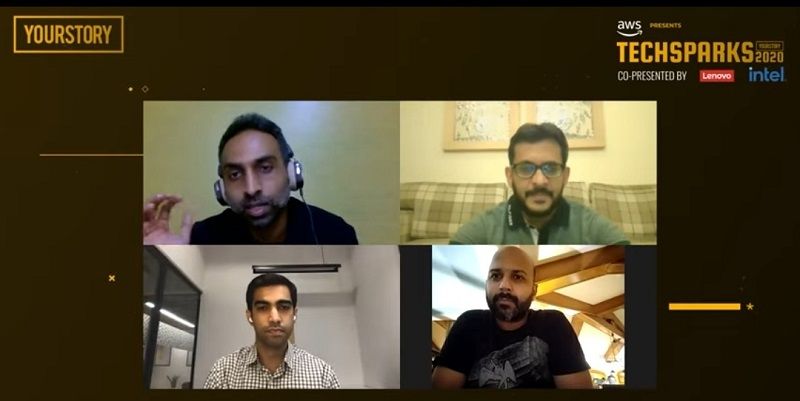Indian retail is booming. According to Boston Consulting Group (BCG), the Indian retail industry is poised to reach $1 trillion by 2025, a huge jump from the $750 billion market size in 2020.
India's insatiable demand for brands is likely to fuel this growth. An Avendus report says the country’s D2C business is going to be worth $100 billion in five years. India has as many as 600 D2C brands – a number that will significantly grow in the next five years — and more than 16 brands with an annual turnover of more than $60 million.
At TechSparks 2020, YourStory’s flagship tech-entrepreneurship event, we caught up with a couple of India's fastest growing brands – baby products and mums’ skincare startup The Moms Co and audio products company boAt — along with India's leading D2C investor Fireside Ventures to discuss what makes India a fertile ground for new-age brands.
Vinay Singh, Co-founder and Partner, Fireside Ventures, said they wanted to support indigenous brands and the timing was right when it came to the Indian consumer.
“The consumer had discretionary income to spend and their habits were shaped by social media. In this new world, a brand could access the consumer through their mind measure, based on their time spent in social media, and could use distribution through ecommerce to meet consumer needs. These two mega trends led to the rise of new brands in India,” he said.
Tapping the opportunity
Startups such as boAt and Moms Co, which were built by the founders based on personal experiences, are tapping this trend.
The Moms Co was built when the founders realised that there weren't any good skincare products for newborns and mothers. It was a niche category that large FMCG companies did not have a strong foothold in.
"We realised the need for a premium product range for babies and moms, which nobody else was doing. Earlier, brands took years to build because of mass media and physical distribution. But social media now enables us to reach new customers quickly, with ecommerce helping build a brand faster. We serviced 7,000 PIN codes in the first year itself,” said Mohit Sadaani, Co-founder of The Moms Co.
In India, a brand would typically achieve Rs 100 crore in revenue over two decades. But audio tech brand boAt did this in less than three years.
Aman Gupta, Co-founder of boAt, said: “Consumers were not looking at price only in our category. It was becoming a fashion statement and people were carrying headphones everywhere. Several people said online was not a category for earphones and headphones. But we addressed the lifestyle element – that a headphone is part of your work, entertainment, education, and fitness – and the numbers started growing.”
“Of course, one has to listen to customers about what the category should do for them and show them the value in the pricing and the technology.”

Top left to right: Vishal Krishna (Business Editor, YourStory) and Aman Gupta (Co-founder of boAt),
Bottom left to right: Mohit Sadaani (Co-founder of Moms Co), Vinay Singh (Co-founder of Fireside Ventures)
Young population, new choices
Factors such as rising income and increased exposure have also changed the game in favour of new-age brands. India's population median is the youngest in the world and they want to buy products that suit their lifestyle rather than buy something that doesn’t define who they are.
“We saw this happening with China, which went from a utilitarian economy to a consumption economy. This trend will be accentuated if India's per capita income keeps rising," Vinay Singh said.
The other big trend that has had an impact is the number of screens. Today, every age group has a device and is consuming content, which allows brands to communicate different values. These young people, who felt disenfranchised by large brands, decided to start spending on new brands.
"We can micro segment and talk to different people on social media. These people have a high rate of acceptance if you have great products. Our products are clinically tested; our product expertise is key and this is where we can compete with any MNC. Our category was a tough one to build because mothers have to trust the brand to use it regularly,” Mohit said.
The lack of physical distribution infrastructure, including a network of wholesalers, distributors, and retailers, has also helped new brands.
"If you must go in for physical distribution in India, you must understand the cycle of credit. It's not easy - you will run out of money if the distribution ecosystem does not pay on time and there is no way of telling what the customer likes or dislikes about the brand. You are at the mercy of the distribution channel. But, now that our online business is big and we get feedback from customers, we are able to serve our physical channels better," Aman said.
The growth of ecommerce and the mindset of the new Indian consumer have helped grow India’s D2C market and are setting it up for further progress.
TechSparks - YourStory's annual flagship event - has been India's largest and most important technology, innovation, and entrepreneurship summit for over a decade, bringing together entrepreneurs, policymakers, technologists, investors, mentors, and business leaders for stories, conversations, collaborations, and connections that matter. As TechSparks 2020 goes all virtual and global in its 11th edition, we want to thank you for the tremendous support we've received from all of you throughout our journey and give a huge shoutout to our sponsors of TechSparks 2020.
Edited by Teja Lele Desai
Link : https://yourstory.com/2020/11/techsparks-2020-india-booming-market-d2c-brands
Author :- Vishal Krishna ( )
November 14, 2020 at 06:45AM
YourStory


